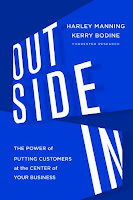 Building blocks of building customer service from the seminal work - Outside -in paraphrased in my words!
Building blocks of building customer service from the seminal work - Outside -in paraphrased in my words!
- Service Strategy
- Best defined as intended experience, what is the kind of experience that you wish to extend to your users. Is it going to be COSTCO or Apple? Is it going to be an Airtel or LG? It is important to clearly define what is it that you wish to extend to your customers as experience. The strategy, therefore, is an expression of intent more than anything else.
- Understanding of the customer
- Knowing who your customers are what is it that they want? What their expectations are from the organisation? Understanding customer expectations is only the half job done. What is it that they call good service? Archetypical segregation of customers is a good way to devise a strategy that will fit different kinds of customers that have to be dealt with. The methods that can be deployed range between
- Solicited feedback and other unsolicited ways.
- Surveys and using various opportunities to interact with the customers to form an understanding about them.
- Communicating the findings with the staff is another equally important thing to do as only after they understand what the expectation is, will they be able to deliver on them.
- Solicited feedback and other unsolicited ways.
- Knowing who your customers are what is it that they want? What their expectations are from the organisation? Understanding customer expectations is only the half job done. What is it that they call good service? Archetypical segregation of customers is a good way to devise a strategy that will fit different kinds of customers that have to be dealt with. The methods that can be deployed range between
- Service Design
- Everything between envisioning and implementation of interactions that create the customer experience. It is about being intentional about designing the process, people, technology, platform, and inter-departmental exchanges to tailor the kind of customer experience that the brand wants to extend. It also is about opening a lab kind of a concept in which, feedback from customers and understanding of the staff and the partners on the impediments to excellent exchange between the customer and the company can happen, to be discussed and solutions to be found. It is about making sure that no bad design makes it to the real customer world. It is about bringing intentionality into the entire process.
- Measurement
- Is a discipline that makes the organisation measure the quality of customer experience by assigning relevant metrics to it, that matter the most to customers, in a consistent manner across the organisation. The end goal of measurement is to give actionable insights to the organisation uncovering areas of improvement, alongside given pointed descriptions of :
- What must be fixed immediately?
- What should be improved over time?
- What should be maintained at the same level?
- What should be touted as the strength of the organisation?
- The goal is to understand what are the elements in the organisation that help customers be loyal and then create systems to make sure that those things are taken care of.
- Another important utility of measurement is to put the quality of customer service parameters right up there with business metrics like sales and profitability.
- Is a discipline that makes the organisation measure the quality of customer experience by assigning relevant metrics to it, that matter the most to customers, in a consistent manner across the organisation. The end goal of measurement is to give actionable insights to the organisation uncovering areas of improvement, alongside given pointed descriptions of :
- Governance
- If customer experience strategy is game-plan, governance is the referee and the rule book. The job is to constantly monitor and weed out bad causes from creeping into the customer service design. It is responsible for holding people accountable to the commitment to serve. It can be the conscience keeper and at the same time also a practice that has the ability to steer things back on track, if and when things go wrong.
- Culture
- A set of shared values and behaviours that focus employees on creating exemplary customer service. Culture is the bloodline of any organisation, getting it right is most daunting and time-consuming. It requires constant reinforcement. Three key steps are
- Hiring - Hiring for value fitment, “hire for will and train for skill”. Commitment to service, customer centricity are a few traits that must be evaluated in hiring people.
- Socialising - The stories of the great customer experience must be told and re-told. The objective is to find the right rituals and the routine to reinforce the need to value customers and act in keeping with the highest standard of customer service delivery in mind.
- Reward - It is important to link both formal (promotion, raise, confirmation) and informal awards (spot awards, RNR) to customer experience. Behaviour consistent great customer experience must be rewarded.
- A set of shared values and behaviours that focus employees on creating exemplary customer service. Culture is the bloodline of any organisation, getting it right is most daunting and time-consuming. It requires constant reinforcement. Three key steps are






